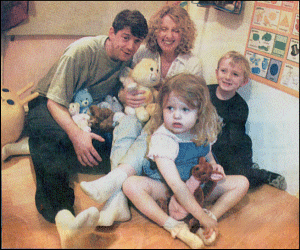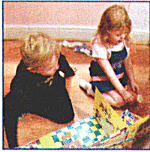A CONTROVERSIAL TREATMENT HAS TRANSFORMED THE LIVES OF AN AUTISTIC CHILD
AND HER FAMILY
-
Autism affects 535,000
people in Britain and it is
estimated that one in 86
schoolchildren is a
sufferer
-
Autism is a lifelong developmental disability that affects
the way a person communicates and relates to people around them
-
The degree of disability caused by autism varies across a spectrum.
Some with classic autism have learning and speech problems, while others
with Asperger's syndrome (which is
on the autism
spectrum) can have above-average intelligence and work independently
-
The exact cause of autism Is unknown but research suggests
genetic factors are important
-
There is no known cure for autism and some medical experts have
expressed concerns about Son-Rise owing to the lack of rigorous scientific
evaluation it has undergone. The National Autistic Society stresses that
the outcome of any approach will vary greatly from individual to individual
will depend on a variety of factors
For information on autism, visit The National Autistic Society
at www.nas.org.uk or Tel 0845 070
4004.
|
 In November 2002, Gill Cuthbert, 39, and her husband, Dave,
35, were devastated when their daughter Laura, then three, was diagnosed
as autistic. They were given hope the following January after learning about
the Son-Rise programme- a treatment system that claims to have 'cured' thousands
of autistic children. They decided to put Laura through it and the results
have been astounding. However, the cost, both financially and emotionally,
has been high. Here, Gill tells her story.
In November 2002, Gill Cuthbert, 39, and her husband, Dave,
35, were devastated when their daughter Laura, then three, was diagnosed
as autistic. They were given hope the following January after learning about
the Son-Rise programme- a treatment system that claims to have 'cured' thousands
of autistic children. They decided to put Laura through it and the results
have been astounding. However, the cost, both financially and emotionally,
has been high. Here, Gill tells her story.
When Laura started on the programme, not long after her third birthday,
she could speak only four words and didn't understand what they meant. She
would throw awful tantrums that lasted hours. She'd hit me, pull her hair
out and even throw furniture. We couldn't get her to put clothes on. And
she wouldn't use the toilet. Now, 18 months later, she doesn't throw tantrums.
She knows thousands of words, can structure sentences, knows
basic maths, dresses herself and is toilet-trained.
It's amazing - her behaviour and social skills are at the same level, if
not beyond, other children her age. You can no longer tell she's autistic.
And it's all down to the Son-Rise programme. When we first heard about it,
we'd almost lost hope. The medical professionals said nothing could be done
and gave us a vision of Laura's future involving special schools and care
homes.
A vision of the future
But the people from Son-Rise offered something else. They showed us examples
of once autistic people who have become fully functional adults and said
if we followed their programme, Laura could do the same. So we decided to
do it, despite the cost and the dramatic change in lifestyle it demanded.
We had to do a number of courses - both here and in the US - that taught
us how to implement the programme and altogether cost nearly £10,000.
I had to give up a well-paid job as a salesperson and we had to build a special
room in the house for Laura. This room is the key to the programme - it is
where the treatment takes place and where Laura still spends around seven
hours a day. She loves it there now but, in the early months, she would do
anything to get out. For the first 12 weeks she had to be locked in against
her will. She would scream and shout for hours on end and even try to crawl
out under the door. It seemed cruel and we found it really hard at first.
Others did, too, and we lost half our friends and family as a result. My
brother-in- law said we were bad parents, and Laura's godmother wouldn't,
and still doesn't, answer my calls. Laura was never locked up on her own,
though; Son-Rise is all about one-to-one contact and either myself, Dave,
one of my other children (Matthew, nine, and Mark, eight) or a volunteer
were, and still are, always in the room with her. But it can seem like a
form of isolation. The room was bare. You put in a mirror at the start and
eventually build it up with toys and books but, initially, you must remove
potential distractions. If the room has a window, a blind must be drawn -
an autistic child can be engrossed for hours watching a branch blowing in
the breeze. We were trying to get Laura excited by people, not things, and
took every opportunity to interact on her level. Once she'd stopped throwing
a tantrum and started doing something, regardless of how repetitive or
ritualistic it was, we'd join in. If she was licking the mirror, we'd lick
the mirror. If she was drawing zigzags on paper, we'd draw zigzags on paper.
Obviously, we wouldn't join in if she started doing something completely
anti-social but we wouldn't shout at her for doing it, either. We'd just
say: 'We don't do that,' and wait for her to do something else.

Making a connection
After three months, we started to get eye contact from Laura. We'd made a
connection, opened a doorway into her world from where we were able to draw
her into ours and teach her all the behavioural and social skills she now
has.
We'll soon be sending Laura to a mainstream school and are full of hope for
her future. The past 18 months have been incredible. It hasn't been easy
and there has been a cost but for us it has been more than worth it.
A series of lectures are taking place across Britain from Sep 16 to Oct
2 offering further information and advice on the Son-Rise programme and other
new autism treatments. To find your nearest lecture and to book seats, Visit
www.son-rise.org
Edited by JAMIE WALTERS
health@ukmetro.co.uk
![Picture:MMP Cambridge [Metro Sep17,2006]](metro/ELEMENT.gif) |
It's an elementary case of vandalism
BRITAIN'S smartest graffiti vandal has got academics - if no one else
- admiring his handiwork. The vandal has spray-painted a perfect diagram
of a chemical compound found in DNA outside a Cambridge laboratory, where
the mysteries of its composition were unravelled half-a-century ago. Over
the top, the artist has written the name of an enzyme, 'phospholipase'. It
is thought to be the work of a chemistry student, perhaps staggering home
after a night celebrating exam success. Cambridge University chemistry lecturer
Dr Jonathan Goodman said: 'The graffiti is of a molecule called guanine.
There is a picture of the molecule on the chemistry department web page.
It is one of the structures, or bases, which make up DNA - one of the four
which Watson and Crick realised could fit together to form DNA in 1953.'
Prof Alan Dawson, from the University of East Anglia in Norwich, added: 'It
is a really nice bit of standard first or second-year biochemistry - but
what it is doing on a Cambridge road is a bit of a mystery. However, officially
at least, Cambridge University was less impressed. A spokeswoman said: 'We
certainly don't want students spraying graffiti on roads. It is not something
we condone |
INDEX
 In November 2002, Gill Cuthbert, 39, and her husband, Dave,
35, were devastated when their daughter Laura, then three, was diagnosed
as autistic. They were given hope the following January after learning about
the Son-Rise programme- a treatment system that claims to have 'cured' thousands
of autistic children. They decided to put Laura through it and the results
have been astounding. However, the cost, both financially and emotionally,
has been high. Here, Gill tells her story.
In November 2002, Gill Cuthbert, 39, and her husband, Dave,
35, were devastated when their daughter Laura, then three, was diagnosed
as autistic. They were given hope the following January after learning about
the Son-Rise programme- a treatment system that claims to have 'cured' thousands
of autistic children. They decided to put Laura through it and the results
have been astounding. However, the cost, both financially and emotionally,
has been high. Here, Gill tells her story.
![Picture:MMP Cambridge [Metro Sep17,2006]](metro/ELEMENT.gif)